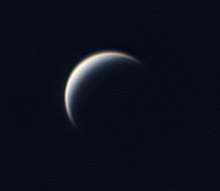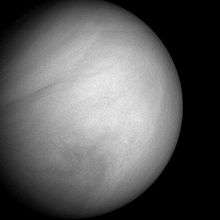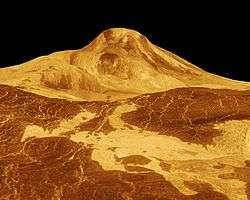Venera

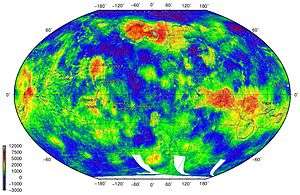
The Venera (Russian: Вене́ра, pronounced [vʲɪˈnʲɛrə]) series space probes were developed by the Soviet Union between 1961 and 1984 to gather data from Venus, Venera being the Russian name for Venus. As with some of the Soviet Union's other planetary probes, the later versions were launched in pairs with a second vehicle being launched soon after the first of the pair.
Ten probes from the Venera series successfully landed on Venus and transmitted data from the surface of Venus, including the two Vega program and Venera-Halley probes. In addition, thirteen Venera probes successfully transmitted data from the atmosphere of Venus.
Among the other results, probes of the series became the first human-made devices to enter the atmosphere of another planet (Venera 4 on October 18, 1967), to make a soft landing on another planet (Venera 7 on December 15, 1970), to return images from the planetary surface (Venera 9 on June 8, 1975), and to perform high-resolution radar mapping studies of Venus (Venera 15 on June 2, 1983). The later probes in the Venera series successfully carried out their mission, providing the first direct observations of the surface of Venus. Since the surface conditions on Venus are extreme, the probes only survived on the surface for durations varying between 23 minutes (initial probes) up to about 2 hours (final probes).
The Venera probes
Venera 1 and 2
The first Soviet attempt at a flyby probe to Venus was launched on February 4, 1961, but failed to leave Earth orbit. In keeping with the Soviet policy at that time of not announcing details of failed missions, the launch was announced under the name Tyazhely Sputnik ("Heavy Satellite"). It is also known as Venera 1VA.[1]
Venera 1 and Venera 2 were intended as fly-by probes to fly past Venus without entering orbit. Venera 1 was launched on February 12, 1961. Telemetry on the probe failed seven days after launch. It is believed to have passed within 100,000 km (62,000 mi) of Venus and remains in heliocentric orbit. Venera 2 launched on November 12, 1965, but also suffered a telemetry failure after leaving Earth orbit.
Several other failed attempts at Venus flyby probes were launched by the Soviet Union in the early 1960s,[2][3] but were not announced as planetary missions at the time, and hence did not officially receive the "Venera" designation.
Venera 3 to 6
.jpg)
The Venera 3 to 6 probes were similar. Weighing approximately one ton, and launched by the Molniya-type booster rocket, they included a cruise "bus" and a spherical atmospheric entry probe. The probes were optimised for atmospheric measurements, but not equipped with any special landing apparatus. Although it was hoped they would reach the surface still functioning, the first probes failed almost immediately, thereby disabling data transmission to Earth.
Venera 3 became the first human-made object to impact another planet's surface as it crash-landed on March 1, 1966. However, as the spacecraft's dataprobes had failed upon atmospheric penetration, no data from within the Venusian boundary were retrieved from the mission.
On 18 October 1967, Venera 4 became the first spacecraft to measure the atmosphere of another planet. While the Soviet Union initially claimed the craft reached the surface intact, re-analysis including atmospheric occultation data from the American Mariner 5 spacecraft that flew by Venus the day after its arrival demonstrated that Venus's surface pressure was 75-100 atmospheres, much higher than Venera 4's 25 atm hull strength, and the claim was retracted.
Realizing the ships would be crushed before reaching the surface, the Soviets launched Venera 5 and Venera 6 as atmospheric probes. Designed to jettison nearly half their payload prior to entering the planet's atmosphere, these craft recorded 53 and 51 minutes of data, respectively, while slowly descending by parachute before their batteries failed.
Venera 7
The Venera 7 probe was the first one designed to survive Venus surface conditions and to make a soft landing. Massively overbuilt to ensure survival, it had few experiments on board, and scientific output from the mission was further limited due to an internal switchboard failure which stuck in the "transmit temperature" position. Still, the control scientists succeeded in extrapolating the pressure (90 atm) from the temperature data with 465 °C (869 °F), which resulted from the first direct surface measurements. The Doppler measurements of the Venera 4 to 7 probes were the first evidence of the existence of high-speed zonal winds (up to 100 metres per second (330 ft/s) or 362 kilometres per hour (225 mph)) in the Venusian atmosphere (super rotation).
Venera 7's parachute failed shortly before landing very close to the surface. It impacted at 17 metres per second (56 ft/s) and toppled over, but survived. Due to the resultant antenna misalignment, the radio signal was very weak, but was detected (with temperature telemetry) for 23 more minutes before its batteries expired. Thus, it became, on 15 December 1970, the first human-made probe to transmit data from the surface of Venus.
Venera 8
Venera 8 was equipped with an extended set of scientific instruments for studying the surface (gamma-spectrometer etc.). The cruise bus of Venera 7 and 8 was similar to that of earlier ones, with the design ascending to the Zond 3 mission. The lander transmitted data during the descent and landed in sunlight. It measured the light level but had no camera. It continued to send back data for almost an hour.
Venera 9 to 12
The Venera 9 to 12 probes were of a different design. They weighed approximately five tons and were launched by the powerful Proton booster. They included a transfer and relay bus that had engines to brake into Venus orbit (Venera 9 and 10, 15 and 16) and to serve as receiver and relay for the entry probe's transmissions. The entry probe was attached to the top of the bus in a spherical heat shield. The probes were optimized for surface operations with an unusual looking design that included a spherical compartment to protect the electronics from atmospheric pressure and heat for as long as possible. Beneath this was a shock absorbing "crush ring" for landing. Above the pressure sphere was a cylindrical antenna structure and a wide dish shaped structure that resembled an antenna but was actually an aerobrake. They were designed to operate on the surface for a minimum of 30 minutes. Instruments varied on different missions, but included cameras and atmospheric and soil analysis equipment. All four landers had problems with some or all of their camera lens caps not releasing.
The Venera 9 lander operated for at least 53 minutes and took pictures with one of two cameras; the other lens cap did not release.
The Venera 10 lander operated for at least 65 minutes and took pictures with one of two cameras; the other lens cap did not release.
The Venera 11 lander operated for at least 95 minutes but neither cameras' lens caps released.
The Venera 12 lander operated for at least 110 minutes but neither cameras' lens caps released.
Venera 13 and 14
The descent craft/lander contained most of the instrumentation and electronics, and was topped by an antenna. The design was similar to the earlier Venera 9–12 landers. They carried instruments to take scientific measurements of the ground and atmosphere once landed, including cameras, a microphone, a drill and surface sampler, and a seismometer. They also had instruments to record electric discharges during its descent phase through the Venusian atmosphere.
The two descent craft landed about 950 km (590 mi) apart, just east of the eastern extension of an elevated region known as Phoebe Regio. The Venera 13 lander survived for 127 minutes, and the Venera 14 lander for 57 minutes, where the planned design life was only 32 minutes. The Venera 14 craft had the misfortune of ejecting the camera lens cap directly under the surface compressibility tester arm, and returned information for the compressibility of the lens cap rather than the surface. The descent vehicles transmitted data to the buses, which acted as data relays as they flew by Venus.
Veneras 15 and 16
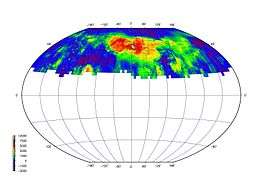
Venera 15 and 16 were similar to previous probes, but replaced the entry probes with surface imaging radar equipment. Radar imaging was necessary to penetrate the dense cloud of Venus.
Vega probes
The Vega (Cyrillic: ВеГа) probes to Venus and comet 1/P Halley launched in 1985 also used this basic Venera design, including landers but also atmospheric balloons which relayed data for about two days. "Vega" is an agglutination of the words "Venera" (Venus in Russian) and "Gallei" (Halley in Russian).
Scientific findings
There were many scientific findings about Venus from the data retrieved by the Venera probes. For example, after analyzing the radar images returned from Venera 15 and 16, it was concluded that the ridges and grooves on the surface of Venus were the result of tectonic deformations.[4]
Venera camera successes and failures
The Venera 9 and 10 landers had two cameras each. Only one functioned because the lens covers failed to separate from the second camera on each lander. The design was changed for Venera 11 and 12, but this change made the problem worse and all cameras failed on those missions. Venera 13 and 14 were the only landers on which all cameras worked properly; although unfortunately, the titanium lens cap on Venera 14 landed precisely on the area which was targeted by the soil compression probe.
The external link at the bottom of the page shows all lander imagery.
Types of Venera probes
| Model | Type | First Launch | Last Launch | Missions (success / total) | Launch Vehicle | Mass | Equipment |
|---|---|---|---|---|---|---|---|
| 1VA | Impact | 04/02/1961 | 12/02/1961 | 0/2 | Molniya | 643.5 kg (1,419 lb) | 5 Scientific instruments |
| 2MV-1 | Flyby and Atmospheric probe | 25/08/1962 | 01/09/1962 | 0/2 | Molniya | 1,097 kg (2,418 lb) | 11 Scientific instruments |
| 2MV-2 | Flyby | 12/09/1962 | 12/09/1962 | 0/1 | Molniya | 890 kg (1,960 lb) | 10 Scientific instruments |
| 3MV-1 and 1A | Flyby | 19/02/1964 | 02/04/1964 | 0/3 | Molniya | 800 kg (1,800 lb) (1A) and 948 kg (2,090 lb) | 10 Scientific instruments |
| 3MV-4 | Flyby | 12/11/1965 | 23/11/1965 | 0/2 | Molniya-M | 963 kg (2,123 lb) | 11 Scientific instruments |
| 3MV-3 | Atmospheric probe and Lander | 16/11/1965 | 16/11/1965 | 0/1 | Molniya-M | 958 kg (2,112 lb) | 10 Scientific instruments |
| 1V | Atmospheric probe and Lander | 12/06/1967 | 17/06/1967 | 1/2 | Molniya-M | 1,106 kg (2,438 lb) | 8 Scientific instruments |
| 2V | Atmospheric probe and Lander | 05/01/1969 | 10/01/1969 | 2/2 | Molniya-M | 1,130 kg (2,490 lb) | 8 Scientific instruments |
| 3V | Atmospheric probe and Lander | 17/08/1970 | 31/03/1972 | 2/4 | Molniya-M | 1,180 kg (2,600 lb) | 5 or 9 Scientific instruments |
| 4V-1 and 1M | Orbiter and Lander | 22/10/1975 | 04/11/1981 | 6/6 | Proton-K | 4,363 kg (9,619 lb) 5,033 kg (11,096 lb) | 16 and 21 Scientific instruments |
| 4V-2 | Orbiter | 02/06/1983 | 07/06/1983 | 2/2 | Proton-K | 5,250 kg (11,570 lb) 5,300 kg (11,700 lb) | 7 Scientific instruments with radar |
Flight data for all Venera missions
| Name | Mission | Launch | Arrival | Survival time min | Results | Orbiter or probe (flyby, atmospheric) | Lander coordin. |
|---|---|---|---|---|---|---|---|
| 1VA (proto-Venera) | Flyby | February 4, 1961 | N/A | N/A | Failed to leave earth orbit | N/A | |
| Venera 1 | Flyby | February 12, 1961 | N/A | N/A | Communications lost en route to Venus | N/A | |
| Venera 2MV-1 No.1 | Atmospheric probe | August 25, 1962 | N/A | N/A | Escape stage failed; Re-entered three days later | 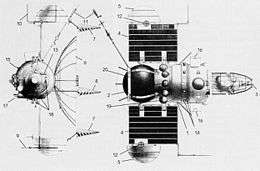 | N/A |
| Venera 2MV-1 No.2 | Atmospheric probe | September 1, 1962 | N/A | N/A | Escape stage failed; Re-entered five days later |  | N/A |
| Venera 2MV-2 No.1 | Flyby | September 12, 1962 | N/A | N/A | Third stage exploded; Spacecraft destroyed |  | N/A |
| Venera 3MV-1 No.2 | Flyby | February 19, 1964 | N/A | N/A | Did not reach parking orbit | N/A | |
| Kosmos 27 | Flyby | March 27, 1964 | N/A | N/A | Escape stage failed | N/A | |
| Venera 2 | Flyby | November 12, 1965 | N/A | N/A | Communications lost just before arrival | N/A | |
| Venera 3 | Atmospheric probe | November 16, 1965 | N/A | N/A | Communications lost just before atmospheric entry. This was the first manmade object to land on another planet on March 1966 (crash). Probable landing region: -20° to 20° N, 60° to 80° E. | N/A | |
| Kosmos 96 | Atmospheric probe | November 23, 1965 | N/A | N/A | Failed to leave Earth orbit and reentered the atmosphere. Believed by some researchers to have crashed near Kecksburg, Pennsylvania, USA on December 9, 1965, an event which became known as the "Kecksburg Incident" among UFO researchers. All Soviet spacecraft that never left Earth orbit, were customarily renamed "Kosmos" regardless of the craft's intended mission. The name is also given to other Soviet/Russian spacecraft that are intended to—and do reach Earth orbit. | N/A | |
| Venera 4 | Atmospheric probe | June 12, 1967 | October 18, 1967 | N/A | The first probe to enter another planet's atmosphere and return data. Although it did not transmit from the surface, this was the first interplanetary transmission of any probe. Landed somewhere near latitude 19° N, longitude 38° E. | N/A | |
| Kosmos 167 | Atmospheric probe | June 17, 1967 | N/A | N/A | Escape stage failed; Re-entered eight days later | N/A | |
| Venera 5 | Atmospheric probe | January 5, 1969 | May 16, 1969 | 53* | Successfully returned atmospheric data before being crushed by pressure within 26 kilometres (16 mi) of the surface. Landed at 3° S, 18° E. | N/A | |
| Venera 6 | Atmospheric probe | January 10, 1969 | May 17, 1969 | 51* | Successfully returned atmospheric data before being crushed by pressure within 11 kilometres (6.8 mi) of the surface. Landed at 5° S, 23° E. | N/A | |
| Venera 7 | Lander | August 17, 1970 | December 15, 1970 | 23 | The first successful landing of a spacecraft on another planet, and the first transmission from another planet's surface. Survived for 23 minutes before succumbing to heat and pressure. |  | 5°S 351°E / 5°S 351°E |
| Kosmos 359 | Lander | August 22, 1970 | N/A | N/A | Escape stage failed; Ended up in an elliptical Earth orbit | N/A | N/A |
| Venera 8 | Lander | March 27, 1972 | July 22, 1972 | 50 | Landed within a 150 kilometres (93 mi) radius of 10.70° S, 335.25° E. | 10°S 335°E / 10°S 335°E | |
| Kosmos 482 | Probe | March 31, 1972 | N/A | N/A | Escape stage exploded during Trans-Venus injection; Some pieces re-entered and others remained in Earth orbit | N/A | N/A |
| Venera 9 | Orbiter and Lander | June 8, 1975 | October 22, 1975 | 53 | Sent back the first (black and white) images of Venus' surface. Landed within a 150 kilometres (93 mi) radius of 31.01° N, 291.64° E. | 31°N 291°E / 31°N 291°E | |
| Venera 10 | Orbiter and Lander | June 14, 1975 | October 25, 1975 | 65 | Landed within a 150 kilometres (93 mi) radius of 15.42° N, 291.51° E. | 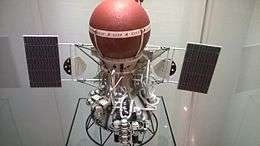 | 15°42′N 291°51′E / 15.700°N 291.850°E |
| Venera 11 | Flyby and Lander | September 9, 1978 | December 25, 1978 | 95 | The lander arrived, but the imaging systems failed. | 14°S 299°E / 14°S 299°E | |
| Venera 12 | Flyby and Lander | September 14, 1978 | December 21, 1978 | 110 | The lander recorded what is thought to be lightning. | 07°S 294°E / 7°S 294°E | |
| Venera 13 | Flyby and Lander | October 30, 1981 | March 1, 1982 | 127 | Returned the first colour images of Venus' surface, and discovered leucite basalt in a soil sample using a spectrometer. | 07°05′S 303°00′E / 7.083°S 303.000°E | |
| Venera 14 | Flyby and Lander | November 14, 1981 | March 5, 1982 | 57 | A soil sample revealed tholeiitic basalt (similar to that found on Earth's mid-ocean ridges). | 13°25′S 310°00′E / 13.417°S 310.000°E | |
| Venera 15 | Orbiter | June 2, 1983 | October 10, 1983 | N/A | Mapped (along with Venera 16) the northern hemisphere down to 30 degrees from North (resolution 1-2 km) | N/A | |
| Venera 16 | Orbiter | June 7, 1983 | October 14, 1983 | N/A | Mapped (along with Venera 15) the northern hemisphere down to 30 degrees from North (resolution 1-2 km) | N/A | |
| Vega 1 | Flyby and Lander | December 15, 1984 | June 11, 1985 | N/A | Part of the Vega program. The vessel was en route to Halley's Comet. During entry into atmosphere, the surface instruments began work early, and the lander failed. See Vega 1. | 07°05′N 177°07′E / 7.083°N 177.117°E | |
| Vega 2 | Flyby and Lander | December 21, 1984 | June 15, 1985 | 56 | Part of the Vega program. The vessel was en route to Halley's Comet. See Vega 2. | 08°05′S 177°07′E / 8.083°S 177.117°E |
See also
- Astron (spacecraft) – a space observatory derived from the Venera bus
- Pioneer Venus project
- Venera-D – First post-Soviet Venus probe (to be launched in 2024)
References
- ↑ Wade, Mark. "Venera 1VA". Encyclopedia Astronautica. Archived from the original on 9 September 2010. Retrieved 28 July 2010.
- ↑ NSSDC Chronology of Venus Exploration (NASA Goddard Space Flight Center), see also NSSDC Tentatively Identified (Soviet) Missions and Launch Failures (NASA Goddard Space Center), accessed August 9, 2010
- ↑ Ultimax Group's Venus Exploration Atlas Archived 2011-07-08 at the Wayback Machine. page (accessed Aug 18 2010)
- ↑ Basilevsky, A. T.; Pronin, A. A.; Ronca, L. B.; Kryuchkov, V. P.; Sukhanov, A. L.; Markov, M. S. (1986). "Styles of tectonic deformations of Venus - Analysis of Venera 15 and 16 data (abstract only)". Journal of Geophysical Research. Journal of Geophysical Research March 30, 1986, p. D399-D411. 91: 399. Bibcode:1986JGR....91..399B. doi:10.1029/JB091iB04p0D399. ISSN 0148-0227.
- ↑ Huntress et all p. 49-266 op. cit.
External links
| Wikimedia Commons has media related to Venera program. |


